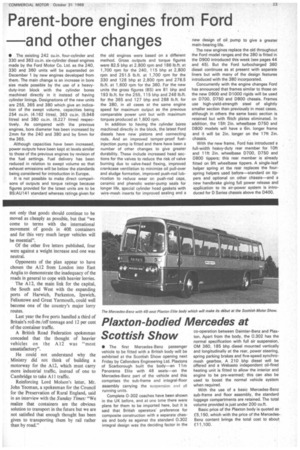Parent-bore engines from Ford and other changes
Page 25

If you've noticed an error in this article please click here to report it so we can fix it.
• The existing 242 cu.in. four-cylinder and 330 and 363 cu.in. six-cylinder diesel engines made by the Ford Motor Co. Ltd. as the 240, 330 and 360 units will be superseded on December 1 by new engines developed from them. The main change is an increase in bore size made possible by the use of a heavyduty-iron block with the cylinder bores machined directly in it instead of having cylinder linings. Designations of the new units are 255, 365 and 380 which give an indication of the swept volume, capacities being 254 cu.in. (4.162 litres), 363 cu.in, 15.948 litres) and 380 coin. (6.227 litres) respectively. As compared with the previous engines, bore diameter has been increased by 2mm for the 240 and 380 and by 5mm for the 365.
Although capacities have been increased, power outputs have been kept at levels similar to those of the previous engines by revision of the fuel settings. Fuel delivery has been reduced in relation to swept volume so that exhaust emissions will be below the standards being considered for introduction in Europe.
It is not possible to make direct comparisons of outputs and torque ratings because figures provided for the latest units are to be BS:AU141 standard whereas ratings given for
the old engines were based on a different method. Gross outputs and torque figures were 82.5 bhp at 2,800 rpm and 186 lb.ft. at 1,700 rpm for the 240, 115 bhp at 2,800 rpm and 251.5 lb.ft. at 1,700 rpm for the 330 and 128 bhp at 2,800 rpm and 276.5 lb.ft. at 1,600 rpm for the 360. For the new units the gross figures (BS) are 81 bhp and 193 lb.ft. for the 255, 115 bhp and 248 lb.ft. for the 365 and 127 bhp and 288 lb.ft. for the 380, in all cases at the same engine speed for maximum output as the previous comparable power unit but with maximum torques produced at 1,600 rpm.
In addition to having the cylinder bores machined directly in the block, the latest Ford diesels have new pistons and connecting rods. And an improved tamper-proof fuelinjection pump is fitted and there have been a number of other changes to give greater durability. These include increased head sections for the valves to reduce the risk of valve burning due to valve-head flexing, improved crankcase ventilation to minimize oil pull-over and sludge formation, improved push-rod lubrication to reduce wear on push-rod caps, ceramic and phenolic water-pump seals for longer life, special cylinder head gaskets with wire-mesh inserts for improved sealing and a new design of oil pump to give a greater main-bearing life.
The new engines replace the old throughout the Ford model ranges, and the 380 is fitted in the 0900 introduced this week Isee pages 44 and 45). But the Ford turbocharged 360 diesel continues as at present with separate liners but with many of the design features introduced with the 380 incorporated.
Concurrently with the engine changes Ford has announced that frames similar to those on the new 0900 and D)000 rigids will be used on D700, D750 and D800 chassis. Frames use high-yield-strength steel of slightly smaller section than previously in most cases, although in others the same basic section is retained but with flitch plates eliminated. In addition, the 15ft 2in, wheelbase D750 and D800 models will have a 6in. longer frame and it will be 2in. longer on the 17ft 2in. chassis.
With the new frame, Ford has introduced a full-width heavy-duty rear member for 10ft and lift 2in. wheelbase D700, 0750 and D800 tippers; this rear member is already fitted on 9ft wheelbase tippers. A single-leaf helper spring at the rear replaces the fourspring helpers used before—standard on tippers and optional on other chassis—and a new handbrake giving full power release and application to its air-power system is introduced for D Series chassis above the D400,


























































































































